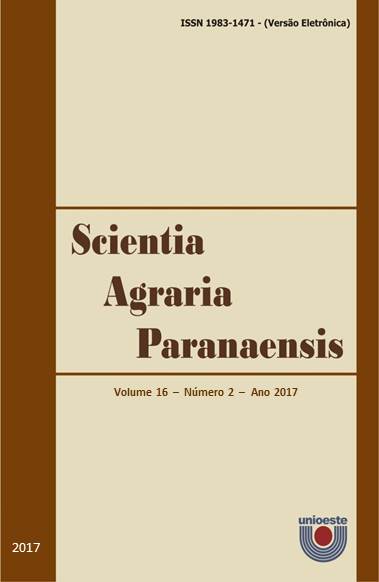Artificial inoculation with Stenocarpella maydis in hybrids of maize
Palavras-chave:
rancind grains, white ear rot, Zea mays L.Resumo
The aim of this work was to evaluate the behavior of commercial corn hybrids, with or without artificial inoculation of Stenocarpella maydis fungus. Experiments were conducted along the harvesting periods of 2010/11 and 2011/12, in Guarapuava, Paraná State, Brazil. Treatments were evaluated in a factorial scheme 4 (commercial hybrids) x 2 (with and without artificial inoculation). The statistical design was a randomized full blocks in a factorial scheme. The following characteristics were evaluated, amount of rancid grains, weight of a thousand grains and yield of grains. There was an impact of agricultural harvest on the incidence of rancind grains independently of artificial inoculation with S. maydis fungus. Hybrid DKB390Y was prominent as the genotype most susceptible to S. maydis fungus independently of the agricultural harvest and the presence or not of artificial inoculation.
Downloads
Publicado
Como Citar
Edição
Seção
Licença
Aviso de Direito Autoral Creative Commons
Política para Periódicos de Acesso Livre
Autores que publicam nesta revista concordam com os seguintes termos:
1. Autores mantém os direitos autorais e concedem à revista o direito de primeira publicação, com o trabalho simultaneamente licenciado sob a Licença Creative Commons Attribution que permite o compartilhamento do trabalho com reconhecimento da autoria e publicação inicial nesta revista.2. Autores têm autorização para assumir contratos adicionais separadamente, para distribuição não-exclusiva da versão do trabalho publicada nesta revista (ex.: publicar em repositório institucional ou como capítulo de livro), com reconhecimento de autoria e publicação inicial nesta revista.
3. Autores têm permissão e são estimulados a publicar e distribuir seu trabalho online (ex.: em repositórios institucionais ou na sua página pessoal) a qualquer ponto antes ou durante o processo editorial, já que isso pode gerar alterações produtivas, bem como aumentar o impacto e a citação do trabalho publicado (Veja O Efeito do Acesso Livre).
Licença Creative Commons
Esta obra está licenciada com uma Licença Creative Commons Atribuição-NãoComercial-CompartilhaIgual 4.0 Internacional, o que permite compartilhar, copiar, distribuir, exibir, reproduzir, a totalidade ou partes desde que não tenha objetivo comercial e sejam citados os autores e a fonte.


